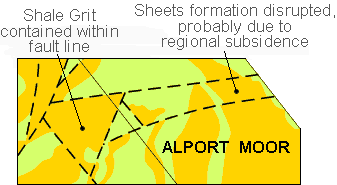There are three different mudstone formations found in the study area.
- Kinderscout Grit.
- Millstone Grit.
- Shale Grit.
Remind yourself how underwater basins were filled with sediments.
See the drift geology of the transect.
Kinderscout Grits
- These mudstones are deltaic deposits.
- The rocks occur in large, wide horizontal sheets.
- This sandstone with little mud composition, indicates a delta origin as shows no signs of meandering streams or incised valleys in the rock.
- Therefore, wide, braided channels were once dominant here.
- Kinderscout grits are coarse grained because their origins are from the delta mouth, where fluvial systems terminate and drop their heavier load.
Where are the Kinderscout grits?.
Millstone Grits
- These grits were formed by deposits of a major braided river channel.
- Much of the deposition of Millstone Grits in Derbyshire originate from large turbidity currents slowing down channels in underwater fans.
- Fast moving currents caused by excess density, carried a large sediment load.
- As currents slowed, the sedimentary load was dropped as the water comes to rest.
- This resulted in long, thin beds of sediment forming at river slow-points - leaving long, thin beds of Millstone Grit rocks
Where are the Millstone Grits?
Shale Grits
- These Grit formations are sand-rich.
- They originate from deep-water systems, where turbidity currents issuing from submarine fan channels filled the Central Pennines Basin.
- Because they are deep water deposits, they are found today in valley bottoms (e.g. Longdendale, below Torside Reservoir) and other low points.
Other factors influencing sediment deposition
- Rift events during valley infill stages also affected sediment thickness and facies across them.
- Fault lines are shown on the transect diagrams as dashed lines (- - - -). Their effect on the rock formation can be clearly seen.

- The patterns are caused by sudden changes in rock either side of the fault where one side has slipped sideways or been moved upwards.
- Regional subsidence caused by seismic occurrences may also have affected the sediment accumulation within the basins.
Find out more about the Geology of the Longdendale area...